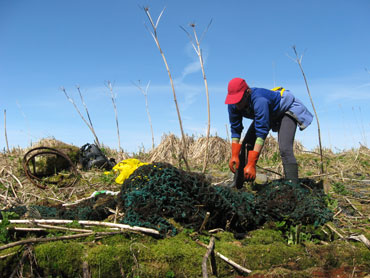NOAA Fisheries News Releases
NEWS RELEASE
March 20, 2009
Sheela McLean, Public Affairs
(907) 586-7032
NOAA publishes book on marine debris in Alaska

A volunteer removes a section of trawl net from Green Island in Prince William Sound in an effort supported by a NOAA grant to Gulf of Alaska Keeper
NOAA’s Alaska Sea Grant Program has published a new book on marine debris in Alaska edited by two NOAA Fisheries employees from Anchorage.
Michael Williams and Erika Ammann organized and edited the 136-page paperback book, which is intended to educate people about marine debris in Alaska and to foster coordination of marine debris removal.
'Marine Debris in Alaska—Coordinating Our Efforts' contains information from NOAA, Alaska conservation groups, Alaska tribal organizations, removal technology experts, chemistry experts and the recycling industry.
"The book captures information that was presented by national and local experts at a NOAA-sponsored 2008 marine debris workshop in Anchorage", said co-editor Michael Williams, who is the Pribilof Islands Program Manager for NOAA Fisheries’ Alaska Region.
Topics in the book range from an overview of NOAA’s national and international efforts to reduce marine debris, to a write-ups on citizen-based efforts to clean debris off Alaska’s remote coastlines, to a presentation on unmanned aerial systems and buoy technologies for locating and tracking marine debris in the high seas, to entanglement of marine mammals in marine debris, to the mechanics of net recycling.
"We tried to capture information presented at the marine debris workshop and present it for further use," said co-editor Erika Ammann, who works for NOAA’s habitat conservation division. "We also captured the very knowledgeable group’s responses to seven main questions about marine debris in Alaska."
The seven questions were:
- Where and how accessible are regional shore-cast marine debris accumulations?
- Is standardized marine debris data collection possible?
- What can be done with collected marine debris?
- How can we prevent and reduce marine debris sources through education and outreach?
- How can emergent programs for marine debris remove and prevention be developed?
- How does marine debris affect wildlife and the environment?
- What criteria should be applied to prioritizing marine debris cleanups in Alaska?
‘Marine Debris in Alaska’ is listed in the 2009 Alaska Sea Grant catalog and can be found at www.alaskaseagrant.org. For more information about NOAA’s marine debris programs please visit www.marinedebris.noaa.gov.
NOAA understands and predicts changes in the Earth's environment, from the depths of the ocean to the surface of the sun, and conserves and manages our coastal and marine resources. Visit http://www.noaa.gov. To learn more about NOAA Fisheries in Alaska, visit http://alaskafisheries.noaa.gov or: www.afsc.noaa.gov